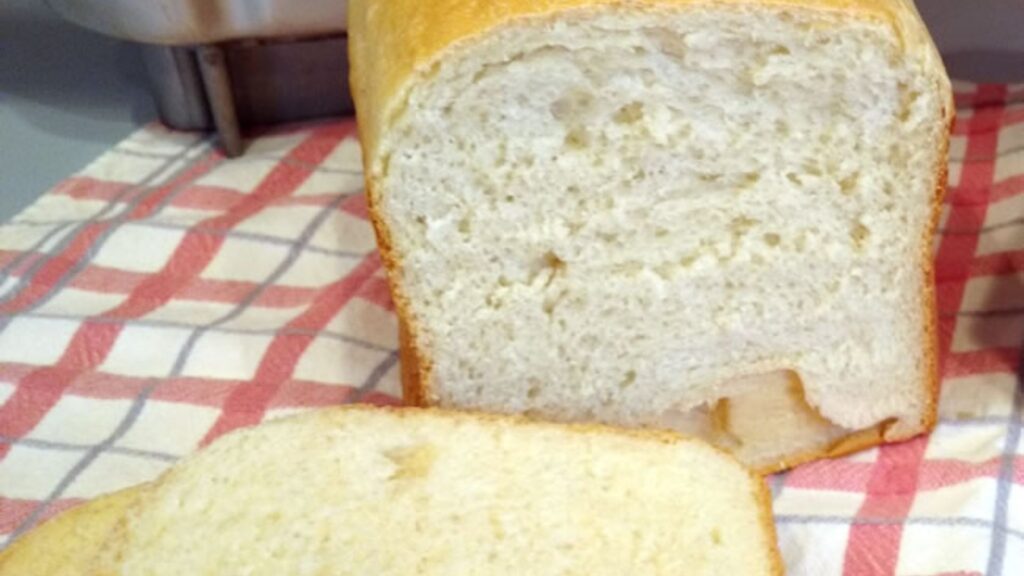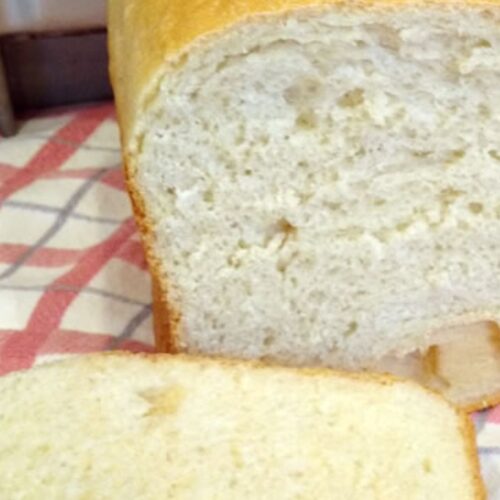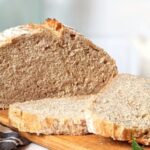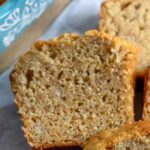This low salt bread recipe has always been a staple in my kitchen. I love baking fresh loaves from scratch. Over the years, I’ve explored healthier ways to enjoy it without giving up taste.
For anyone watching their sodium intake, I’ve crafted something special. After many tests and tweaks, I finally perfected this low salt bread recipe. It’s soft, flavorful, and easy to make at home.
I use simple ingredients and no fancy tools. This bread fits right into a heart-healthy diet. It pairs well with anything and freezes beautifully. Want a better bread option, this recipe is the one to try.
Why You Will Choose Low Salt Bread Recipe?
I choose this low salt bread recipe because it supports my health without compromising on taste. It helps me manage my sodium intake, especially when trying to eat heart-friendly meals.
I love that I can control every ingredient and still enjoy soft, fresh bread. It’s perfect for anyone looking to make smarter food choices without giving up comfort and flavor.
How To Prepare Low Salt Bread Recipe
Recipe Overview
Preparation Time: 15 minutes
Rising Time: 1 hour 30 minutes
Baking Time: 30 minutes
Total Time: 2 hours 15 minutes
Course: Bread
Cuisine: American, Health-Focused
Yield: 1 loaf (8–10 slices)
Equipment Needed
- Large mixing bowl
- Measuring cups and spoons
- Wooden spoon or dough hook mixer
- Loaf pan (8×4 inch)
- Clean kitchen towel
- Oven
Ingredients
- 3 cups all-purpose flour (or bread flour for a chewier texture)
- 1 packet (2¼ tsp) active dry yeast
- 1 tbsp olive oil
- 1 tsp sugar (to activate yeast)
- 1¼ cups warm water (around 110°F / 43°C)
- Optional: ½ tsp salt (or none if fully low-sodium)
- Optional toppings: unsalted seeds (sunflower, pumpkin, sesame)

Directions
1. Activate the Yeast
In a small bowl, combine warm water and sugar. Stir in the active dry yeast and let it sit for about 5–10 minutes until it becomes foamy. This step is key to ensuring the dough rises properly without salt slowing it down.
2. Mix the Dough
In a large mixing bowl, add flour and optional salt. Pour in the yeast mixture and olive oil. Stir with a wooden spoon until it begins to form a shaggy dough. If you’re using a stand mixer, switch to the dough hook and knead on low speed.
3. Knead Until Smooth
Transfer the dough to a lightly floured surface and knead for about 8–10 minutes by hand, or 5–6 minutes using the mixer. The dough should feel soft and slightly tacky, but not sticky.
4. First Rise
Place the kneaded dough into a greased bowl. Cover it with a clean kitchen towel and let it rise in a warm spot for 1 hour or until it doubles in size.
5. Shape the Dough
After the dough has risen, punch it down gently to release air bubbles. Shape it into a loaf and place it into a greased 8×4-inch loaf pan.
6. Second Rise
Cover the pan with a towel and let the dough rise again for about 30 minutes. It should rise just above the edge of the pan.
7. Bake
Preheat your oven to 375°F (190°C). Bake the bread for 30 minutes until golden brown. The top should sound hollow when tapped.
8. Cool and Slice
Remove the bread from the oven and let it cool in the pan for 10 minutes. Transfer to a wire rack to cool completely before slicing.
Special Note
Managing a strict low-sodium diet, feel free to omit the salt entirely. The olive oil adds subtle richness, and using quality flour really makes a difference in flavor and texture.
You can also mix in herbs like rosemary or thyme for a flavorful twist—just make sure they’re salt-free.
Nutrition Facts Low Salt Bread Recipe
Calories: 130
Carbohydrates: 24g
Protein: 4g
Fat: 2.5g
Fiber: 1g
Sugar: 0.5g
Sodium: 35–75mg (depending on added salt)
Tips And Techniques
5 Tips and Techniques for Perfect Low Salt Bread Recipe
1. Use Fresh Yeast or Active Dry Yeast Wisely: Without salt to regulate yeast activity, the dough can rise faster. Keep an eye on the proofing time to avoid over-proofing.
2. Enhance Flavor with Herbs or Seeds: Add dried herbs like rosemary, thyme, or garlic powder to boost flavor naturally. Seeds like flax or sunflower add texture and nutrition.
3. Use Warm Water, Not Hot: Yeast thrives in warm water (around 100°F or 38°C). Hot water can kill it, and cold water can slow the rise.
4. Add Flavor Naturally: Since salt is minimal, I like to mix in herbs like oregano or basil, or even a touch of garlic powder. These simple additions boost flavor without raising sodium.
Healthy Nutrition Benefits
This low salt bread offers several health benefits. It supports heart health by reducing sodium intake, which helps manage blood pressure. The use of whole ingredients provides fiber for better digestion and longer-lasting energy.
It’s also free from preservatives, making it a cleaner, more natural choice. Each slice nourishes without the hidden risks found in many store-bought breads.
How To Store Leftovers Low Salt Bread Recipe
I always store leftover low salt bread in an airtight container or a resealable bag at room temperature for up to 3 days. To keep it fresh longer, I slice the loaf and freeze individual pieces.
That way, I can toast a slice whenever I need it without wasting any. Just avoid storing it in the fridge—it tends to dry out faster there.
Which Bread Is Lowest In Salt?
The bread lowest in salt is Ezekiel 4:9 Low Sodium Bread, which contains zero sodium per slice. It’s made from sprouted whole grains and is best enjoyed toasted for better flavor and texture.
Another great option is Alvarado Street Bakery No Salt Added Bread, with just 10 mg of sodium per slice. It offers excellent taste and a softer texture, even when not toasted.
Both are often found in the freezer section of health-oriented grocery stores and are ideal choices for anyone watching their sodium intake.
How Do You Reduce Salt In Homemade Bread?
To reduce salt in homemade bread, I start by simply cutting down the amount of salt in the recipe or removing it entirely. If you reduce the salt by 50%, then reduce the yeast by 50%.
Since salt helps control yeast, I watch the dough closely to avoid over-proofing. possibly more, and you’ll need to watch the dough carefully during rising.
What Is A Substitute For Salt In Bread Making?
When I bake bread without salt, I like to use natural flavor boosters as substitutes. Herbs like rosemary, thyme, or basil add depth and aroma. Garlic or onion powder works well too.
A splash of vinegar or lemon juice can brighten the flavor subtly. Sometimes, I add a bit of unsalted butter or olive oil to improve taste and texture.
While these don’t replicate salt exactly, they bring a satisfying richness that makes the bread feel complete.
What Is Bread Without Salt Called?
Bread made without salt is often referred to as “saltless bread” or “unsalted bread”. In some cultures, it’s called “pane sciocco”, especially in Italy, where it’s a traditional recipe.
This type of bread typically has a milder taste and is used to complement strongly flavored dishes, as it lacks the seasoning salt provides.
While it might seem bland on its own, saltless bread is often appreciated for its simplicity and natural texture.
Conclusion
Baking this low salt bread recipe has become part of my weekly routine. It gives me peace of mind knowing exactly what goes into each slice. I don’t have to sacrifice flavor to eat healthier.
The process is simple, and the results are always satisfying. Cutting back on sodium for health reasons or just want a cleaner alternative to store-bought bread, this recipe makes it easy.
I hope you enjoy making it as much as I do. Give it a try, and let it become a wholesome staple in your kitchen too.

Low Salt Bread Recipe
Equipment
- Large mixing bowl
- Measuring cups and spoons
- Wooden spoon or dough hook mixer
- Loaf pan (8×4 inch)
- Clean kitchen towel
- Oven
Ingredients
- 3 cups all-purpose flour or bread flour for a chewier texture
- 1 packet 2¼ tsp active dry yeast
- 1 tbsp olive oil
- 1 tsp sugar to activate yeast
- 1¼ cups warm water around 110°F / 43°C
- Optional: ½ tsp salt or none if fully low-sodium
- Optional toppings: unsalted seeds sunflower, pumpkin, sesame
Instructions
Activate the Yeast
- In a small bowl, combine warm water and sugar. Stir in the active dry yeast and let it sit for about 5–10 minutes until it becomes foamy. This step is key to ensuring the dough rises properly without salt slowing it down.
Mix the Dough
- In a large mixing bowl, add flour and optional salt. Pour in the yeast mixture and olive oil. Stir with a wooden spoon until it begins to form a shaggy dough. If you’re using a stand mixer, switch to the dough hook and knead on low speed.
Knead Until Smooth
- Transfer the dough to a lightly floured surface and knead for about 8–10 minutes by hand, or 5–6 minutes using the mixer. The dough should feel soft and slightly tacky, but not sticky.
First Rise
- Place the kneaded dough into a greased bowl. Cover it with a clean kitchen towel and let it rise in a warm spot for 1 hour or until it doubles in size.
Shape the Dough
- After the dough has risen, punch it down gently to release air bubbles. Shape it into a loaf and place it into a greased 8×4-inch loaf pan.
Second Rise
- Cover the pan with a towel and let the dough rise again for about 30 minutes. It should rise just above the edge of the pan.
Bake
- Preheat your oven to 375°F (190°C). Bake the bread for 30 minutes until golden brown. The top should sound hollow when tapped.
Cool and Slice
- Remove the bread from the oven and let it cool in the pan for 10 minutes. Transfer to a wire rack to cool completely before slicing.
Notes

Hi, I’m Delina, a housewife, mother of two living in the suburbs of Vancouver, Canada. I’m a professional recipe developer and food photographer behind thefoodscraft.com. Although I was trained in biological technology for lab work, my heart is in the kitchen. Growing up, family dinners were a nightly tradition, and as a single mom of two, I was determined to keep that alive. With limited ingredients, I discovered the magic of transforming basic items into cozy family meals, which inspires all my recipes. In 2017, I started thefoodscraft.com, sharing budget-friendly recipes and tips.

